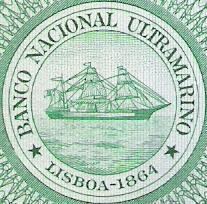Industry Banking Website www.bnu.com.mo Number of employees 400 (2013) | ||
 | ||
Type Wholly owned subsidiary | ||
Almo o banco nacional ultramarino
Banco Nacional Ultramarino ([ˈbɐ̃ku nɐsiuˈnaɫ uɫtɾɐmɐˈɾinu]; Chinese: 大西洋銀行; English: National Overseas Bank) was a Portuguese bank with operations throughout the world, especially in Portugal's former overseas provinces. It ceased existence as an independent legal entity in Portugal following its merger with Caixa Geral de Depósitos, the government-owned savings bank, in 2001. The Chinese name's meaning is literally Great West Ocean Bank or Atlantic Bank.
Contents
The Bank continues operations today under the Banco Nacional Ultramarino brand in Macau, a Chinese Special Administrative Region and former Portuguese colony, where it is also licensed to issue Macanese pataca banknotes.
Sede do banco nacional ultramarino
Timeline
Banco Nacional Ultramarino (BNU) was established in Lisbon, Portugal, in 1864 as a bank of issue for Portuguese overseas territories. the next year it opened branches in Luanda, Angola and Praia, Cabo Verde. Three years after that, in 1868, BNU opened branches in São Tomé and Príncipe, Goa, and Mozambique.
In 1901 BNU lost its banking monopoly, but retained its note-issuing monopoly in the countries in which BNU operated. The next year, BNU opened branches in Macau and in Bolama, Portuguese Guinea (present-day Guinea-Bissau).
Just before World War 1, in 1912, BNU opened branches in Dili, East Timor (present-day Timor Leste, and in Brazil.
In 1952 BNU closed its branches in India.
In 1965 BNU, Banco Português do Atlântico, Banco de Angola, and the South African company, General Mining and Finance, founded Bank of Lisbon and South Africa. This was later renamed Mercantile Lisbon Bank.
In the 1970s, BNU bought a stake in Banque Interatlantique in Luxembourg, and established a representative office in London.
In 1974 the Portuguese government nationalized BNU, following the Carnation Revolution. Immediately thereafter, in 1975, local governments nationalized BNU's interests in Mozambique, which became Banco de Moçambique, and in São Tomé and Príncipe, which became National Bank of São Tomé and Príncipe. In 1993, the government split National Bank into a central bank, Central Bank of São Tomé and Príncipe, and a commercial bank, Banco Internacional de Sao Tome e Principe. In Cape Verde, BNU's interests became Bank of Cape Verde. In 1993, the government spun off the commercial banking operations into a new bank, Banco Comercial do Atlantico.
